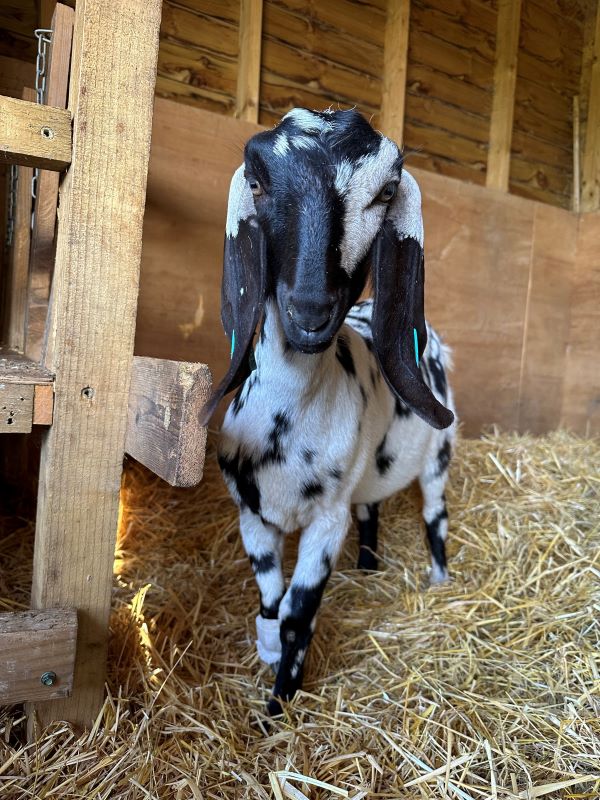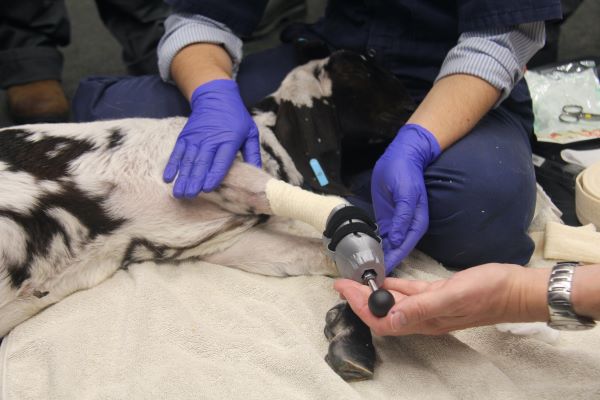No kidding! Goat given new lease of life with 3D printed foot
A Nubian goat named Thistle has successfully been fitted with a 3D printed prosthetic foot, after suffering from a severely fractured limb as a kid.

Thistle was five weeks old when she was first referred to the Royal Veterinary College’s (RVC) Equine Referral Hospital, after being born with a suspected deformity. After diagnosis of fractured digits by her vet, she was sent to the RVC for further evaluation and treatment.
A CT scan revealed chronic, open, comminuted, displaced, non-articular, diaphyseal fractures of the phalanges. There was also complete loss of preservation with suggestions of septic arthritis and luxation.
Treatment options were discussed with the owner and included euthanasia, and amputation at the level of the radius and amputation at the level of the distal metacarpi, with the hope to fit a prosthesis on the distal limb.
After opting for amputation at the level of the distal metacarpi, the procedure was carried out under general anaesthesia, with a postoperative CT performed to obtain exact measurements of the stump. Taking this information, Professor Richard Bomphrey of the Structure and Motion Lab at the RVC worked alongside Dr Perrier and her team to design and manufacture the 3D-printed prosthetic foot for Thistle.
Thistle recovered well from the amputation and returned to the RVC three weeks later to have the sutures removed and the new prosthetic limb fitted. The prosthesis resembled a ski boot with Velcro straps and was 3D printed with Polylactic Acid (PLA) filament which is a recyclable, natural thermoplastic polyester that is derived from renewable resources such as corn starch or sugar cane. A threaded bolt was inserted at the bottom to allow for adjustments in height as she grows. Several modifications were made to the design of the prosthesis over the course of her stay to make it more comfortable and, in particular, easier for her to lay down.
Melanie Perrier, Senior Lecturer in Equine Soft Tissue Surgery at the RVC said:
“Thistle's progress and her initial response to the prosthesis are very encouraging. While she initially only used the prosthesis for a few steps, after a few days she was mostly weight-bearing on it and showing a more natural gait.
“As Thistle had been walking on three legs since birth she presented with severe muscle atrophy over her right forelimb, and so this will need to be built up progressively. She will wear her prosthetic for a little longer each day and undergo regular physiotherapy exercises. She will only wear the prosthesis for a few hours daily to start with so she can get accustomed to it gently, and this will be increased over the following weeks and months so that ultimately, she can wear her prosthesis throughout the day.”

Debbie Dale, Thistle’s owner, said:
“I have always been very attached to having goats. Thistle was a twin and had some ligament issues from birth. We don’t know what caused the injury to her foot. Initial assessments were pointing towards having her having no option other than being put to sleep due to the extreme extent of the amputation she needed.
“I was convinced that due to her being so young and so well in every other way – that we needed to explore prosthetics as an alternative. Luckily, my vet agreed and referred us to the RVC where I met Melanie and the team. Thistle’s mum was allowed to come to the appointment as Thistle was still feeding from her at the time. The RVC team thoroughly investigated our options – even contacting other vet specialists in America before we ended up having the 3D printed prosthetic leg fitted. I am over the moon with Thistle’s progress. She’s back to her agile self – even bullying her brothers!”
At present, Thistle wears the prosthesis for up to four hours twice daily. While she is apparently very attached to her new foot and is reluctant to have it removed, she becomes tender if the prosthesis is left for a longer period of time. The owner will therefore continue to increase the amount of time she wears the prosthesis slowly, with the ultimate aim to wear it during the day and have it removed at night.
Thistle has been given physiotherapy exercises by the team at the RVC to help her use the limb and develop her proprioception and musculature. She will need to be continually monitored for pressure sores as she grows, but it looks as though this kid is taking it all in her stride.
About the RVC
- The Royal Veterinary College (RVC) is the UK's largest and longest established independent veterinary school and is a Member Institution of the University of London.
- It is one of the few veterinary schools in the world that hold accreditations from the RCVS in the UK (with reciprocal recognition from the AVBC for Australasia, the VCI for Ireland and the SAVC for South Africa), the EAEVE in the EU, and the AVMA in the USA and Canada.
- The RVC is ranked as the top veterinary school in the world in the QS World University Rankings by subject, 2023.
- The RVC offers undergraduate and postgraduate programmes in veterinary medicine, veterinary nursing and biological sciences.
- The RVC is a research-led institution, with 88% of its research rated as internationally excellent or world class in the Research Excellence Framework 2021.
- The RVC provides animal owners and the veterinary profession with access to expert veterinary care and advice through its teaching hospitals and first opinion practices in London and Hertfordshire.
You may also be interested in:
-
The RVC maintains top performance in Knowledge Exchange Framework for fifth year
The Royal Veterinary College (RVC) has once again secured strong results in the fifth Knowledge …

